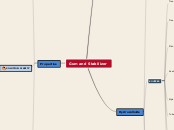Bench Press
Variations
Flat barbell bench press
The bench press is an upper-body strength-training exercise that consists of pressing a weight upwards from a supine position. The exercise works the pectoralis major as well as the supporting chest, arm, and shoulder muscles such as the anterior deltoids, serratus anterior, coracobrachialis, scapulae fixers, trapezii, and the triceps. A barbell is generally used to hold the weight, but a pair of dumbbells can also be used.[1]
1. Lie on the bench with your eyes under the bar
2. Grab the bar with a medium grip-width (thumbs around the bar!)
3. Unrack the bar by straightening your arms
4. Lower the bar to your mid-chest
5. Press the bar back up until your arms are straight
Resistance band bench press
Adds extra resistance throughout the entire movement to place your muscles under constant tension. After you perform variation, a regular Bench Press will feel much lighter, allowing you to increase the amount of weight you can lift.
1. Set up a bench press station with a flat bench.
2. Add the amount of weighted plates you would use for 12 repetitions.
3. Attach one handle of a resistance band to one side of the bar, bring it under the bench and attach the other handle to the opposite side of the bar
4. Lift the bar off the rack and lower it in a smooth and controlled motion until it almost touches your chest.
4. Push the bar straight up with explosive power.
Barbell Incline bench press
forces you to push the bar at an angle, which requires more muscle activation, primarily in the middle and anterior deltoids, making it harder to lift more weight
1. Set up a bench press station with a flat bench.
2.Grasp the bar with an overhand grip, hands close together.
3. Lift the bar off the rack and lower it in a smooth and controlled motion until the bar almost touches your chest.
4. Push the bar straight up while trying to keep the bar level.
barbell decline bench press
Targets the chest muscles—primarily the lower chest muscles—more than a regular Bench Press. Unlike the Incline Bench Press, you are forced to push the bar forward because of the decline. With this exercise, you should be able to lift more weight.
1. Set up a bench press station by adjusting a bench to a 45-degree decline or use a decline bench station.
2. Grasp the bar with an overhand grip, hands about shoulder-width apart.
3. Hook the tops of your feet under the pads at the end of the bench.
4. Lift the bar off the rack and lower it down to chest level in a smooth and controlled motion.
5. Push the bar straight up, resisting the tendency for the bar to move backwards due to the decline
close grip barbell bench press
focuses on building the triceps. Grasp the bar with your hands close together. The chest muscles are not fully activated, requiring the triceps to work harder.
1. Set up a bench press station with a flat bench.
2. Grasp the bar with an overhand grip, hands close together.
3. Lift the bar off the rack and lower it in a smooth and controlled motion until the bar almost touches your chest.
4. Push the bar straight up while trying to keep the bar level.
Common mistakes
Make sure the path of the bar is not low over the mouth and neck region when unracking or racking the bar. That means you should move the weight "from" and "to" the rack from an arms-extended position and not low across the neck and face.
Low Bar
Locking Elbows Suddenly
You can "lock-out" your elbows, contrary to some safety advice that is generally misguided. Just make sure you don't lock them out suddenly or explosively.
Thumb Position
The hand grip should be overhand and feature the thumbs placed under the bar and across the top of the fingers. Don't place the thumbs behind the bar or locked beneath the fingers.
Pushing Head Into Bench
Keep your head flat on the bench and feet flat on the floor for stability, but don't push your head into the bench to assist the lift; firm up the neck muscles instead.
Arched Back and Lifted Buttocks
Your buttocks should remain flat on the bench. Do not emulate the powerlifter style of arching your back so much that your buttocks lift off the bench. This can result in low back pain.
Benefits
Bigger Pec Major
The bench press builds the pec major. This is the muscle most associate getting bigger and working on when benching. It’s the glamour muscle of the chest and what gives pecs their larger, strong appearance. It’s one of the prime movers in horizontal protraction.
improve bone health
When there’s added resistance on the body’s structure, especially from larger movements such as the bench press, promotes bone health.
Muscle growth
Muscle growth is not only desired by bodybuilders, but also for anybody over age 40 when age-related muscle loss is a concern.
restore muscle balance
The bench press can help restore muscle balance for athletes that primarily use pulling muscles, such as in wrestling, rock climbing, and swimming.
Competitive Lift
The barbell bench press is a competitive lift in the sport of powerlifting, with the other two being the deadlift and squat.
History
Bellly toss
It wasn’t until the 1940s and 50s that bodybuilders began to make a change in bench pressing. Bodybuilders interest in the lift would change the way the lift was performed. Because they considered it cheating
strict floor press
At first the strict floor press was the most popular method. In 1899, using a barbell with 48 centimetres (19 in) discs (plates)
George Hackenschmidt
inventor of the barbell hack squat, rolled a barbell over his face (which was turned to the side) and performed a strict floor press with 164 kilograms (362 lb). This stood as a record for 18 years until Joe Nordquest broke it by 1 kilogram (2.2 lb) in 1916.
Muscles worked
Pectoralis minor
a thin, triangular muscle, situated at the upper part of the chest, beneath the pectoralis major in the human body.
Pectoralis major
The pectoralis major (from Latin pectus, meaning 'breast') is a thick, fan-shaped muscle, situated at the chest (anterior) of the human body.
coracobrachialis muscles
the smallest of the three muscles that attach to the coracoid process of the scapula. (The other two muscles are pectoralis minor and the short head of the biceps brachii.) It is situated at the upper and medial part of the arm.
anconeous
a small muscle on the posterior aspect of the elbow joint.
anterior deltoidsanterior deltoids
muscle forming the rounded contour of the human shoulder.









